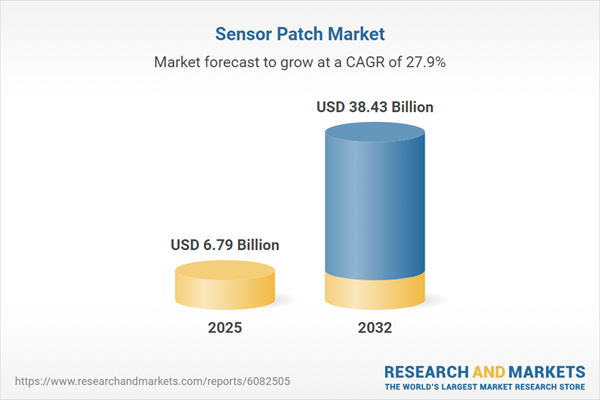Speak directly to the analyst to clarify any post sales queries you may have.
The sensor patch market is rapidly transforming health monitoring by integrating miniaturized electronics and wireless communication within wearable, patient-centric solutions. Senior decision-makers now face a landscape of innovation and regulatory considerations across clinical and consumer applications.
Market Snapshot: Sensor Patch Market Overview
The sensor patch market grew from USD 5.38 billion in 2024 to USD 6.79 billion in 2025. It is expected to continue growing at a CAGR of 27.85%, reaching USD 38.43 billion by 2032. This surge is driven by the convergence of materials science, bioelectronics, and wireless technology, delivering discreet, user-friendly patches for continuous monitoring of critical physiological metrics. As healthcare and wellness emphasize proactive and preventive approaches, demand for real-time biosensing and seamless data flows is expanding across hospitals, clinics, and consumer health segments.
Scope & Segmentation
This comprehensive report explores the dynamic landscape of the sensor patch market, segmented by product, type, position, application, end-user industry, and region. The report covers key technology trends, market drivers, and strategic considerations for supply chain planning and competitive growth.
- Product Range: Blood glucose sensor patches, blood oxygen sensor patches, blood pressure or flow sensor patches, ECG sensor patches, heart rate sensor patches, pain relievers, position sensors, sweat analyzers, and temperature sensor patches.
- Type: Self-adhesive sensor patches and wearable sensor patches designed for integration within garments or accessories.
- Positioning: Bodywear, footwear, neckwear, and wristwear devices, each catering to unique diagnostic, therapeutic, or performance insights.
- Application Focus: Diagnostics, medical therapeutics, and real-time monitoring use cases.
- End-User Industries: Fitness and sports performance optimization, as well as healthcare settings emphasizing clinical accuracy and regulatory compliance.
- Regional Scope: Americas (United States, Canada, Mexico, Brazil, Argentina, Chile, Colombia, Peru), Europe, Middle East & Africa (including United Kingdom, Germany, France, Russia, Italy, Spain, Netherlands, Sweden, Poland, Switzerland, UAE, Saudi Arabia, Qatar, Turkey, Israel, South Africa, Nigeria, Egypt, Kenya), and Asia-Pacific (China, India, Japan, Australia, South Korea, Indonesia, Thailand, Malaysia, Singapore, Taiwan).
- Technologies & Innovation: Miniaturized, flexible substrates; edge computing; AI-enabled analytics; energy-harvesting modules; and integration with cloud-based health platforms.
- Key Industry Players: Abbott Laboratories, Boston Scientific Corporation, Dexcom Inc., Medtronic PLC, GE HealthCare Technologies, iRhythm Technologies, Philips, Nemaura Medical, Masimo Corporation, and others.
Key Takeaways
- Continuous innovation in sensor technology, including nanomaterials and biocompatible adhesives, is redefining comfort and accuracy for both clinical and personal health monitoring.
- Edge computing paired with machine learning is enabling real-time, actionable insights, paving the way for faster interventions and customizable patient care pathways.
- Low-power components and energy-harvesting advances extend device lifespan and support large-scale adoption in remote or mobile populations.
- Ecosystem partnerships, from semiconductor suppliers to healthcare institutions, facilitate integrated solutions, expanding reach into diverse market verticals.
- Versatile segmentation—by product, user type, and application—allows for targeted strategies tailored to regional and industry-specific growth opportunities.
Tariff Impact on Supply Chains and Innovation
The introduction of tariffs on sensor patch components in the United States in 2025 has altered global supply chains. Organizations that previously relied on cross-border sourcing shifted quickly toward supplier diversification, evaluating domestic and emerging market partnerships. While some organizations faced short-term price pressures and updated procurement strategies, others capitalized on opportunities for onshore assembly and improved quality assurance. The changes prompted market consolidation among established firms and opened space for agile niche manufacturers to emerge.
Methodology & Data Sources
This research combines in-depth primary interviews with market leaders, clinicians, regulatory experts, and technology developers with robust secondary data. Multiple industry publications, regulatory filings, and patent databases supported qualitative and quantitative insights. Segmentation modeling and regional framework analysis enabled precise, actionable intelligence for sensor patch ecosystem stakeholders.
Why This Report Matters
- Delivers actionable insights to inform critical procurement, investment, and technology adoption decisions in the rapidly growing wearable medical device sector.
- Enables tailored go-to-market and localization strategies by illuminating the interplay between regulatory, technological, and regional market factors.
- Supports effective risk management and compliance planning by evaluating external drivers, including tariffs, reimbursement policies, and infrastructure limitations.
Conclusion
This report equips decision-makers with the structured insights needed to navigate the evolving sensor patch market. Grounded in thorough analysis, it highlights opportunities for growth, innovation, and strategic resilience within the wearable health technology sector.
Table of Contents
3. Executive Summary
4. Market Overview
7. Cumulative Impact of Artificial Intelligence 2025
Companies Mentioned
The companies profiled in this Sensor Patch market report include:- Abbott Laboratories
- accensors GmbH
- Beneli AB
- Blue Spark Technologies, Inc.
- Boston Scientific Corporation
- Boyd Corporation
- Covestro AG
- Dexcom, Inc.
- DuPont de Nemours, Inc.
- G-Tech Medical Inc.
- GE HealthCare Technologies, Inc.
- Gentag, Inc.
- GTECH Corporation
- iRhythm Technologies, Inc.
- Isansys Lifecare Ltd.
- Kenzen, Inc.
- Koninklijke Philips N.V.
- LifeSignals, Inc. by Renew Health Limited
- Masimo Corporation
- Medtronic PLC
- NanoSonic, Inc.
- Nemaura Medical Inc.
- Nitto Denko Corporation
- PolarSeal Tapes & Conversions Ltd.
- Resonetics
- Sensium Healthcare Limited by The Surgical Company group
- Smith+Nephew PLC
- VitalConnect
- VivaLNK, Inc.
- Vpatch Cardio Pty Ltd.
Table Information
| Report Attribute | Details |
|---|---|
| No. of Pages | 191 |
| Published | November 2025 |
| Forecast Period | 2025 - 2032 |
| Estimated Market Value ( USD | $ 6.79 Billion |
| Forecasted Market Value ( USD | $ 38.43 Billion |
| Compound Annual Growth Rate | 27.8% |
| Regions Covered | Global |
| No. of Companies Mentioned | 31 |








